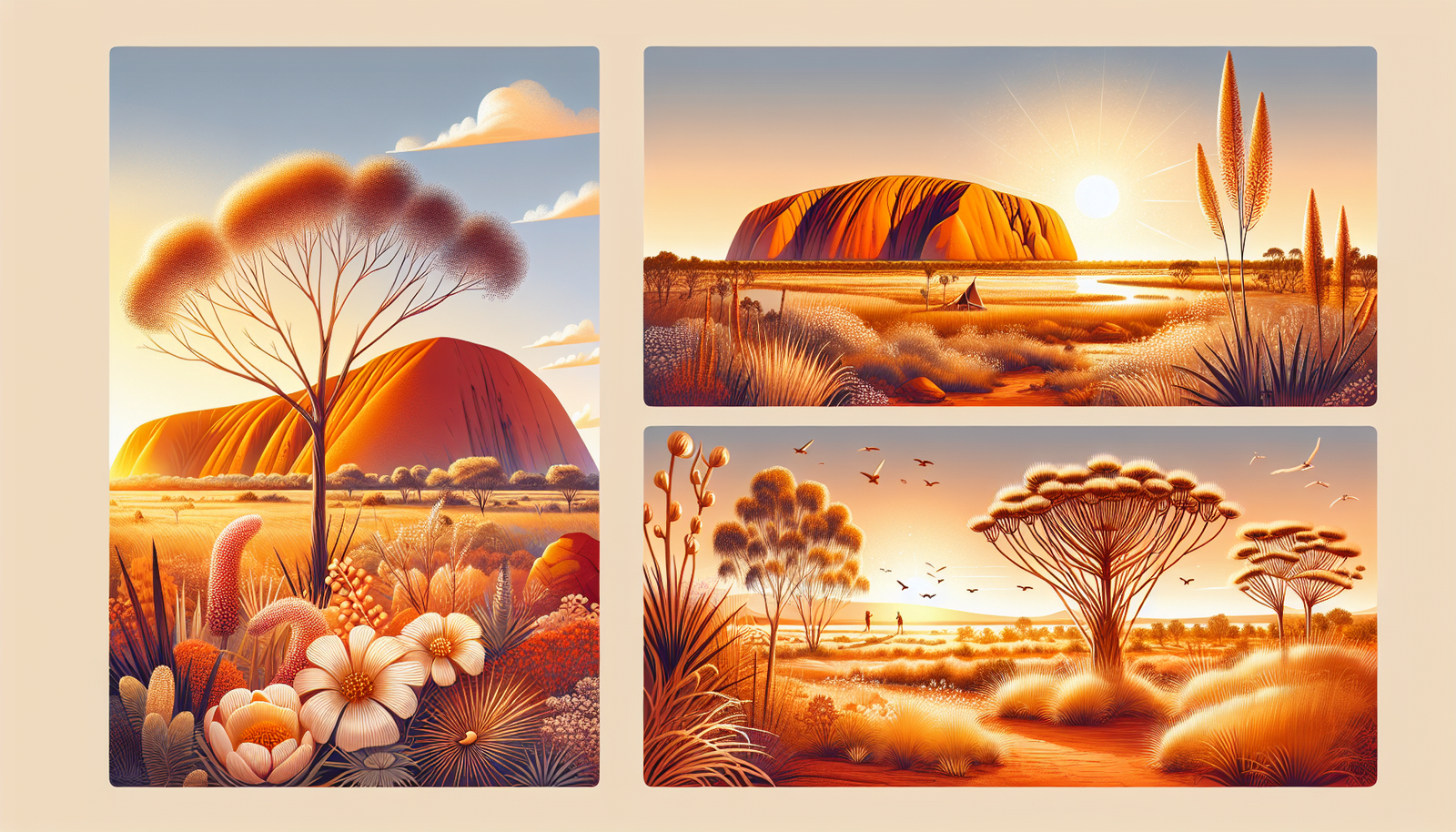Thinking about ticking off Australia’s Red Centre from your bucket list? Well, you’re reading the right article! “Best Time Of Year To Visit Uluru And Alice Springs” is designed just for you. It holds all the essential information you need to adapt your plans and experience the ultimate trip to Uluru and Alice Springs. This article walks you through each season examining the weather, crowd levels, and unique opportunities that would help you decide your ideal time to visit these iconic Aussie landmarks. So, sit back and let this guide lighten your planning load!
Overview of Uluru and Alice Springs
Uluru and Alice Springs are two of the most fascinating and culturally significant destinations in Australia, each offering its unique appeal to visitors from around the globe.
Location and geography
Situated in Australia’s central region, Uluru (also known as Ayers Rock) and Alice Springs are enclosed within the vast stretches of the Northern Territory. The famed sandstone monolith, Uluru, stands tall and proud amidst arid remoteness, casting a spell with its changing hues. On the other hand, Alice Springs serves as the gateway to Australia’s Red Centre, nestled between the MacDonnell Ranges’ rugged peaks and the endless Australian desert.
Cultural significance
Both Uluru and Alice Springs hold immense cultural significance, mainly due to their strong ties with the Aboriginal communities. Uluru is more than just a stunning natural formation; it’s a deeply spiritual place for the Anangu people, the traditional owners of the land, filled with ancient rock art and spiritual lore. Alice Springs is no less significant, hosting a dynamic Aboriginal arts scene and offering glimpses into the Aboriginal culture through its local community events and museums.
Tourist attractions
Apart from the imposing Uluru, tourists are drawn to the majestic Kata Tjuta and Kings Canyon for hiking opportunities and panoramic views. In Alice Springs, attractions range from the historical Telegraph Station and the Alice Springs Desert Park to the exciting hot air balloon rides over the desert.
Seasons in Uluru and Alice Springs
Just like any other travel destination, the experiences you can enjoy in Uluru and Alice Springs will vary depending on the season you choose for your visit.
Summer season
During summer (December to February), the temperature in Uluru and Alice Springs could rise up to 35-40 degrees Celsius. The hot and arid conditions typical of this season make outdoor activities quite challenging, but early morning and late evening outings can offer some respite from the scorching sun.
Autumn season
In autumn (March to May), you’ll find the temperatures dropping slightly, providing more comfortable conditions for outdoor exploration. The daytime temperatures range from 25-30 degrees Celsius, while the morning and night constituents may fall down to 15-20 degrees Celsius.
Winter season
Winter (June to August) brings a refreshing change with cooler days and chilly nights. Temperatures often fall below 10 degrees Celsius at night while hovering around 20 degrees Celsius during the day.
Spring season
Then comes spring (September to November), a transition time when the heat gradually picks up, but remains tolerable for outdoor activities. The temperature averages 20-30 degrees Celsius during the day and 10-20 degrees at night.
Visiting Uluru and Alice Springs in Summer
Temperature and weather conditions
In summer, the temperature often exceeds 35 degrees Celsius in the daytime, which can go up to 40 degrees or more on extreme days. It’s a dry heat, accompanied by intense sunlight.
Advantages of visiting in summer
The bright side of visiting in summer is that popular attractions are less crowded, offering a more tranquil, undisturbed experience. Plus, the early mornings and late evenings can be beautiful, with temperatures cooling down and the landscapes suffused in softer light.
Disadvantages of visiting in summer
The scorching summer heat can make outdoor activities quite strenuous, possibly causing health issues like heat exhaustion or dehydration. Also, some areas of Uluru-Kata Tjuta National Park may be closed due to extreme heat.
Key attractions and activities in summer
Despite the heat, you can enjoy sunrise or sunset viewing at Uluru and Kata Tjuta, attend the atmospheric ‘Field of Light’ art installation at dusk, or explore the peaceful Alice Springs Desert Park in the cooler hours.
Visiting Uluru and Alice Springs in Autumn
Temperature and weather conditions
During autumn, average daytime temperatures hover around the mid to high 20s, providing more pleasant conditions than the harsh summer.
Advantages of visiting in autumn
With milder weather, autumn becomes an excellent time for outdoor activities such as trekking and wildlife-watching. It’s also a great time to indulge in the Aboriginal arts scene in Alice Springs.
Disadvantages of visiting in autumn
While autumn presents milder conditions, there can still be an occasional hot day, and the cooler nights might require additional layers of clothing.
Key attractions and activities in autumn
Autumn is an ideal time to hike through Kings Canyon, visit the Alice Springs Reptile Centre, or attend local events like the BASSINTHEGRASS music festival in Darwin.
Visiting Uluru and Alice Springs in Winter
Temperature and weather conditions
Winter in Uluru and Alice Springs is alike mild winters with daytime temperatures averaging around 20 degrees and drop below 10 degrees at night.
Advantages of visiting in winter
Winter offers some of the most comfortable weather for exploring the outdoor attractions of Uluru and Alice Springs. The cooler climate is ideal for hiking, sightseeing, and enjoying beautiful night skies.
Disadvantages of visiting in winter
The chilly nights might require you to pack additional layers of clothing. With clear skies and lower humidity, winter also sees many tourists, which might result in crowded hotspots.
Key attractions and activities in winter
Your winter visit can include a trek around the base of Uluru, a leisurely stroll at the Olive Pink Botanic Garden, or watching the Milky Way and shooting stars on a clear winter night.
Visiting Uluru and Alice Springs in Spring
Temperature and weather conditions
In spring, daytime temperatures gradually increase and usually range around 20-30 degrees Celsius, while nights remain cool.
Advantages of visiting in spring
Just like autumn, spring offers relatively balmy weather and is fantastic for outdoor activities. Moreover, you may get to see wildflowers in bloom, painting the landscapes in vibrant hues.
Disadvantages of visiting in spring
As temperatures start to rise nearing summer, some days might get quite hot. Also, the demand for accommodation can increase due to the favourable weather, leading to higher prices.
Key attractions and activities in spring
Spotting wildflowers on hiking trails, visiting the Alice Springs School of the Air, and exploring Hermannsburg Historic Precinct could be a part of your spring itinerary.
Visitor facilities in Uluru and Alice Springs
Accommodation options
From luxury hotels and resorts to budget-friendly hostels and campsites, Uluru and Alice Springs cater to a wide range of travellers with varied preferences and budgets. You can choose from the high-end Sails in the Desert or the comfortable Alice Springs YHA, among others.
Transportation systems
Uluru and Alice Springs are both investments in quality transportation systems. Shuttles, organised tours, and car hire services are readily available, while bicycles can be rented for leisurely explorations.
Restaurant and dining options
You’re in for a culinary treat in both Uluru and Alice Springs, with options galore for casual dining, upscale restaurants, or alfresco cafe experiences. Indigenous-inspired dishes and bush tucker (native wild food) can add a unique flavour to your trip.
Shopping and leisure facilities
Souvenir shopping in Uluru and Alice Springs can lead to Aboriginal art galleries, local handicraft stores, and shops selling beautiful pearl jewellery. For leisure, you can enjoy a night at the casinos, relax in spas, or take part in cultural workshops.
Travel tips for visiting Uluru and Alice Springs
What to pack
Depending on the season, you’d want to pack accordingly. Summers call for a good sun hat, sunblock, and lightweight clothing, while the winter months require warm clothing. Don’t forget to pack comfortable walking shoes, reusable water bottles, and a camera to capture the stunning surroundings.
Health and safety tips
Due to the region’s harsh sun and arid conditions, it’s crucial to stay hydrated and protect yourself from the sun. And, given the remote location, ensure you have a well-stocked first aid kit.
Cultural etiquette and rules
Remember to respect Aboriginal customs and rules when visiting Uluru and Alice Springs. For instance, the Anangu people ask that visitors do not climb Uluru due to its spiritual significance. Also, always ask for permission before photographing people or certain sites.
Tips for budget travelers
For budget travellers, camping can be a cost-effective accommodation option. Plan and book in advance to get good deals, and consider self-catering options to save on food costs.

Outdoor Activities in Uluru and Alice Springs
Hiking and trekking
Uluru and Alice Springs offer brilliant hiking and trekking opportunities amidst stunning landscapes. From exploring the base of Uluru to navigating the Larapinta Trail, you’re sure to enjoy these adventures.
Wildlife watching
The diverse desert eco-system is home to unique wildlife, such as wallabies, kangaroos, emus, and myriad bird species that you can spot during your visit.
Photography spots
The changing colours of Uluru with the day, the evening sky speckled with stars, and the rugged beauty of the MacDonnell Ranges offer fantastic photography opportunities.
Cultural tours and experiences
Joining cultural tours and experiences let you delve deep into Aboriginal traditions, learn about their mythology, and even try your hand at indigenous arts and crafts.
Sustainable Tourism in Uluru and Alice Springs
Importance of sustainable tourism
Sustainable tourism is crucial to protect and preserve the natural beauty and cultural significance of Uluru and Alice Springs. It ensures that these unique treasures can be enjoyed by future generations while benefiting the local communities.
Green initiatives in Uluru and Alice Springs
Various green initiatives like water recycling programs, solar power projects, and the promotion of indigenous-owned businesses are in place to support sustainability in Uluru and Alice Springs.
How tourists can contribute to sustainability
As a tourist, you can contribute to sustainability by respecting local customs and rules, using minimal plastic, keeping the environment clean, and supporting local businesses.
So, irrespective of the time you choose to visit Uluru and Alice Springs, prepare yourself to be amidst some of the world’s most captivating natural and cultural wonders. Whether it’s the raw allure of the outback, the deep-seated Aboriginal traditions, or the sheer variety of experiences on offer, your journey to Australia’s Red Centre will indeed leave an indelible impression. Happy travels!







